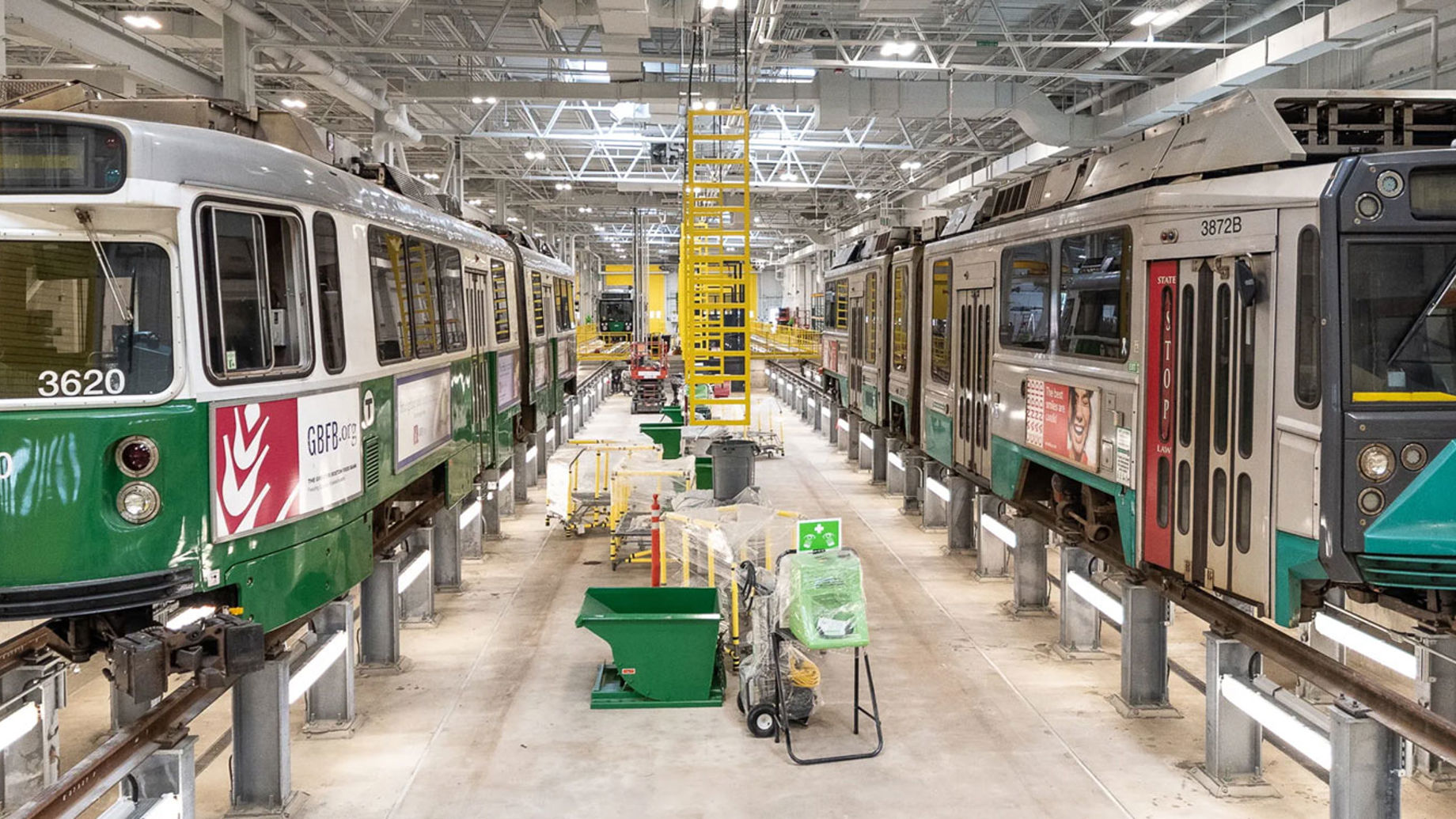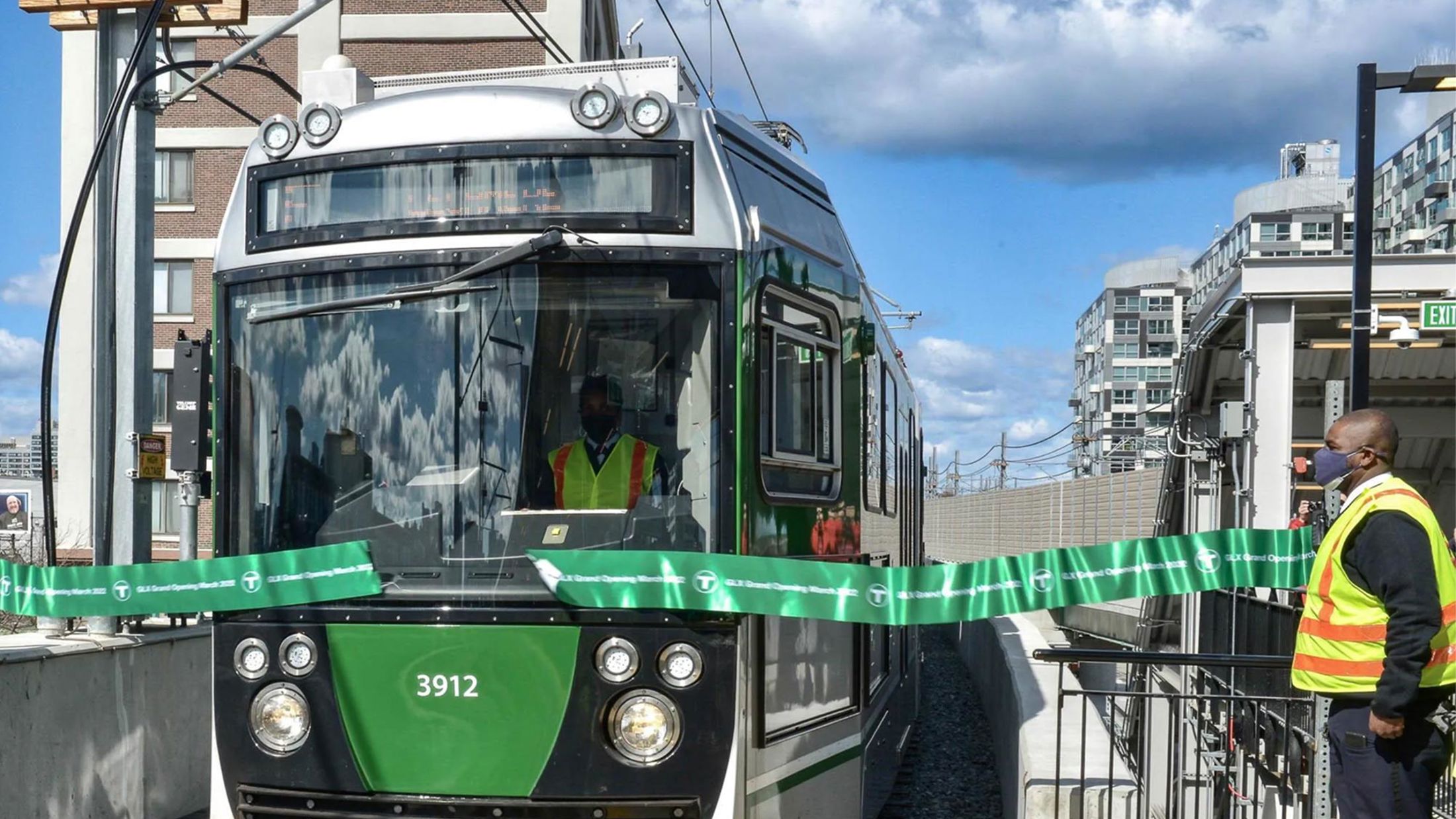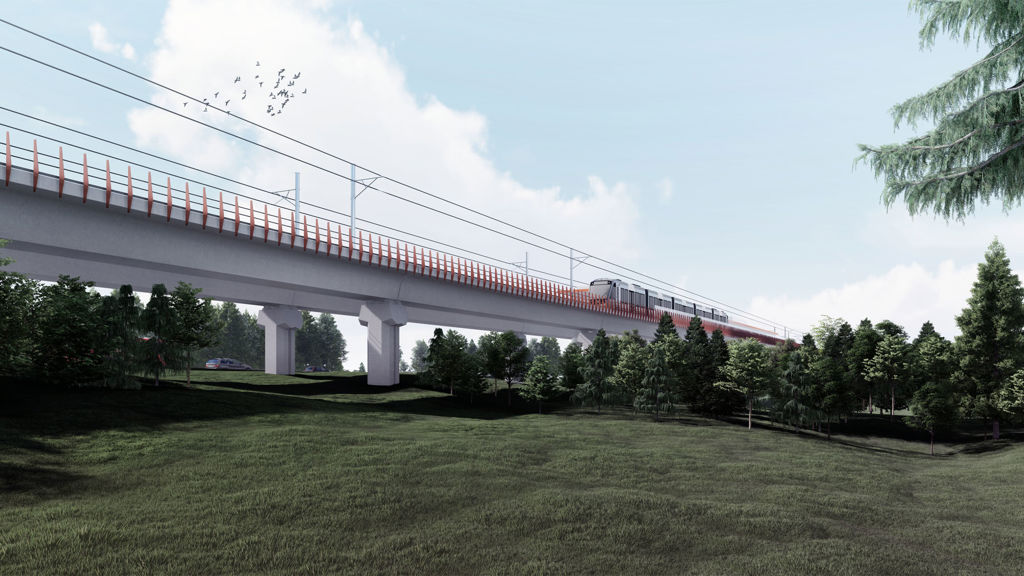A major MBTA design-build project linking Downtown Boston with Union Square and College Avenue
MBTA Green Line Extension

The Green Line Extension (GLX) provides a much-needed direct rail link connecting Downtown Boston to Union Square in Somerville and College Avenue in Medford – two densely populated, historically underserved areas.
Forecast to add 50,000 daily passenger trips to Boston’s transit network, the two-branch light rail extension puts the city one step closer to meeting its goal of carbon neutrality by 2050 by significantly reducing vehicle trips and associated air emissions. The Union Square Branch, the first of the extension’s two branches, opened in March 2022. With the opening of the Medford Branch in December 2022, the GLX project is complete.
The GLX project includes the construction of 4.7 miles of new light rail tracks, the addition of six new stations, along with the relocation and reconstruction of Lechmere station, three new traction power sub-stations, a new vehicle maintenance facility, and a community path extension for cyclists and pedestrians that follows much of the length of the GLX route. The community path serves both to provide access between stations and streets, and it connects Somerville to the Charles River and Downtown Boston; a vital link in the extensive network of regional and statewide bikeways.
The project had been on the drawing board since 1990 but didn’t break ground until 2012. Three years into the project, in August 2015, the MBTA disclosed that the project’s costs had increased significantly—seriously jeopardizing the project.
Bringing costs back under control
Arup’s involvement in the project began in October 2015 when we were hired to perform a full-scale evaluation of all aspects of the project—from scope and schedule to programming and procurement. The assessment identified a variety of interventions that could be used to bring the project’s cost back within original projections. The MassDOT cancelled the project in December 2015 and formed a multidisciplinary Interim Project Management Team (IPMT) to undertake a preliminary redesign aimed at:
- Reducing the project’s cost while maintaining core functionality and benefits
- Exploring alternative procurement options
- Developing a realistic cost estimate and schedule
- Ensuring that the revised project still met the necessary requirements to attain federal funding
As a key member of IPMT, we provided critical technical re-engineering, estimating and scheduling that aided the client in cutting the cost of the project by roughly $700 million. Subsequently, Arup has served as Design Professional, overseeing design development, testing and commissioning, and safety and security verification processes helping to usher the project to completion.
Delivering a lean project with lower costs and increased efficiency
Over the first three years of the GLX project, the original project team worked hard to fulfill the needs and desires of a broad base of public and community stakeholders — many with grand aspirations for the long-awaited transit line. The outcome of these efforts was an inflated project scope and a steep increase in costs. When Arup came on board in October of 2015, it was our job to determine if the project could be scaled back to be more efficient and affordable, while still performing at expected levels.
Delivered in just six weeks, our assessment report provided a list of recommendations that shaved 19 months off the schedule and reduced the estimated project’s cost by $700m. These recommendations included: downsizing stations to eliminate redundancies and unnecessary flourishes; rehabilitation of some of the bridges inside the project’s footprint instead of replacing them; and—most significantly—delivering the project with a design-build contract instead of a construction manager/general contractor delivery model. Our recommendations were included in the IPMT’s full list of recommendations and played a critical role in bringing the revised estimated cost of the program down to $2.3bn.
A trusted design-build partner for GLX
“The decision to go design-build cut close to a year and a half off the overall project schedule—that's a year and a half of contractors' costs,” says Jeff Tubbs, Arup’s Design Professional Project Director. “GLX is the biggest design-build project the MBTA has taken on and Arup’s experience with successfully delivering design-build projects helped give them the confidence to move forward.”

After the decision was made to pursue design-build, the MBTA hired us to assist in the preparation of a set of design-build documents that reflected the rescoped design. As part of the design-build procurement process, we were responsible for the preparation of the Technical Provision. The firm's previous experience with the design-build process proved so valuable to the MBTA that we were then appointed to serve as Design Professional – a role that involved helping the client define internal design-build procurement protocols and assisting them in authoring the Technical Addenda for a Request for Proposals to select a suitable contractor. We also reviewed the new scope to validate that it met the necessary criteria to continue qualifying for 50% federal funding, performed cost estimating, and reviewed all submitted Technical Proposals. In November 2017, GLX Constructors was chosen as the Design-Build entity to construct the project. Our involvement continued in the role of Design Professional to assist the MBTA throughout the project’s design and construction phases.
A perfect deadline track record
Given the project’s previous issues and postponements, MBTA Program Manager John Dalton was committed to seeing the redesign and procurement proceed according to a strict schedule. In our role as Design Professional, we have successfully met all deadlines. This has involved the review of over 500 design package submittals; the review of Management Plans; and submitting responses to over 1100 Requests for Information (RFIs); and the review of over 8000 construction submittals to date – all of which has been completed within budget. This level of efficiency was achieved by embedding a team of eight Arup staff and subconsultants with the client and drawing on more than 100 engineers and consultants at various Arup offices.
From drawing board designs to ground breaking reality
Construction of the GLX broke ground in early 2018, with initial efforts focused on making room for the addition of over four miles of new track within the existing railroad right-of-way and minimising interference with adjacent properties. Where space permitted, the Community Path runs next to the new light-rail tracks. In cases where existing buildings and infrastructure limited space, Arup reviewed the community path as part of the rescoping and initiated the concept of elevating the path separately from the track bed, creating new ramps to minimise bridge reconstruction. This provides a continuous, safe route for cyclists and pedestrians that reconnects to the GLX line at various stations. The pathway also integrates with the streets at various stations, serving as a community connection for all commuters.
The opening of the Medford Branch in December 2022 follows the opening of the Union Branch in March 2022 and brings this momentous project to completion. The GLX project, which is primarily located in Somerville, brings 80% of the community within walking distance of rail transit, compared to a previous 20%. Four years after ground-breaking, and in spite of COVID-related supply-chain delays, GLX’s long-anticipated 2022 opening finally connected the Somerville and Medford communities to much-needed transit, and the community path furthers Boston’s ongoing investment in accessible and safe biking infrastructure as a viable transportation alternative.
What we delivered
-
Rationalising costs and efficiency with an all-points assessment report
-
Delivering an assessment report providing recommendations that shaved 19 months off the schedule and reduced the estimated project’s cost by $700m.
-
Putting 80% of Bostonians within walking distance of a transit hub
Get in touch with our team
Projects
Explore more commuter and mainline rail projects

Connecting communities across the Ellenbrook Line
Morley-Ellenbrook Line Project, Australia

Preserving Brunel’s iconic railway for future generations
Parson's Tunnel Rockfall Shelter, United Kingdom

Improving connectivity and accessibility to public transit in the Greater Toronto Area
Eglinton Crosstown West Extension, Canada

Transforming transit in one of the largest metropolitan areas in North America
GO Expansion – On-Corridor Works (OnCorr), Canada
Get in touch with us
If you'd like to speak to one of our rail experts about any of the issues raised on this page or a potential collaboration then please get in touch by completing the form.

